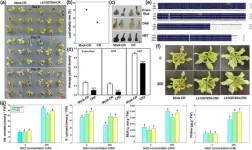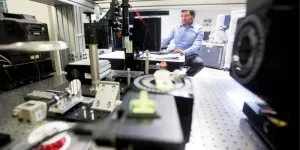(Press-News.org) COLUMBUS, Ohio – Online news consumers tend to click on simpler headlines that use more common words and more readable writing, a new study finds.
Researchers evaluated more than 30,000 real-world field experiments from the Washington Post and the online news site Upworthy to see how readers reacted to headlines of varying complexity.
In addition, a follow-up experiment showed that average readers paid more attention to simpler headlines and processed them more deeply – unlike journalists, who paid just as much attention to complex headlines.
The results show that even though the stories may be complex, simplicity is the key to attracting the attention of busy online readers, said Hillary Shulman, lead author of the study and associate professor of communication at The Ohio State University.
“The Washington Post doesn’t have to turn into clickbait, but we have to acknowledge that the average user has thousands and thousands of choices of what to read – and they prefer simpler writing,” Shulman said.
“It’s in our democratic interest to figure out how to get people to pay attention to important information, and one way is to focus on how headlines are written.”
Shulman conducted the study with David Markowitz, associate professor of communication at Michigan State University, and Todd Rogers of Harvard University. It was published today (June 5) in the journal Science Advances.
In one experiment, the Washington Post gave the authors access to the results of what is called A/B testing of headlines.
The Post would write two or more different versions of a headline for a story and serve them to different readers on the website for a short period of time and see which one was clicked on more. Whichever headline “won” became the headline going forward.
The sample included 7,371 experiments involving more than 19,000 headlines between March 2021 and December 2022.
Findings showed that the most clicked-on headlines almost always scored higher on a simplicity index developed by the researchers. The study identified three hallmarks of simplicity in the winning headlines: They used common words; they avoided analytic writing, which tends to be more formal and complex; and they had fewer words per sentence and syllables per word.
Here’s an example of a headline that appeared briefly on the Post website that scored relatively high in complexity and had fewer reader click-throughs: “Are Meghan and Harry spilling royal tea to Oprah? Don’t bet on it.”
Its winning counterpart scored higher on simplicity and received more clicks: “Meghan and Harry are talking to Oprah. Here’s why they shouldn’t say too much.”
“Small efforts aimed at increasing the simplicity or fluency of language can increase the attention of casual readers – and also make them more informed and educated about the news of the day,” said Markowitz.
The Washington Post, of course, is a well-known legacy newspaper with an established audience. Would the same results be found in an internet-only publication? The researchers tested this by looking at A/B testing for the online news site Upworthy, which posts viral and uplifting content.
The researchers examined data of 22,664 experiments and 105,551 unique headlines from January 2013 to April 2015. Just like in the Washington Post results, the simplicity index was positively associated with how often readers clicked on headlines.
“This result lends credence to the idea that the appeal of simple headlines is a general habit for casual readers, and not just those of readers of sites like the Washington Post,” Shulman said.
In another experiment, online participants read 10 headlines and indicated which headline they would be likely to select if they were reading the news. In this experiment, the researchers rewrote some Washington Post headlines to make them simpler or more complex and included these target headlines among headlines used as controls.
Results showed that when target headlines were re-written more simply, they were selected more frequently (69.4%) than the control headlines (30.6%). But when the target headlines were re-written using more complex language, they were selected less often (44.5%) than the control headlines (55.5%).
And why do people choose simpler headlines? This same study suggests a reason. Several minutes after reading the headlines, participants were presented with a three-word phrase and were asked whether that phrase appeared in the headlines they viewed.
Participants were more likely to accurately remember phrases that appeared in the simple headlines.
“This suggests that that people allocate more attention to simple texts than they do to complex texts,” Shulman said.
But not everyone does that: specifically, not the journalists who write stories and the headlines for a living.
The researchers repeated the same study with a group of professional writers, including mostly current and former journalists. Results showed that headline simplicity did not affect their selection, attention or memory of headlines. They selected and remembered the complex headlines just as often as they did the simple ones.
“Apparently, those who write the news read it differently from those who merely consume it,” Shulman said.
In fact, the journalists didn’t even think like the average reader. The researchers asked the journalist participants to choose which Washington Post headlines they thought won among the general public in A/B testing. The journalists did no better than chance at correctly identifying what the public liked.
“Journalists may not be the best suited to write headlines because they seem to read differently than the general public,” she said.
Shulman said getting the headline right is vital for attracting readers to stories at a place like the Washington Post. The Post had an average of 70 million digital unique visitors to its site per month during the time of the study.
So if only 0.10% more readers click on a story because it has a simpler headline (2.1% versus 2.0%), that would still equal a difference of more than 200,000 readers.
The findings of this study complement earlier research by Shulman and colleagues that found the use of jargon in writing about politics and science causes readers to tune out.
Together, they make a case for journalists that simplicity in writing is key.
“Many less credible and highly polarized sources online use simpler writing,” Shulman said.
“The best way to increase demand for good, credible journalism is to realize that simpler is better. That’s the way to compete in the attention economy.”
END
Simple headlines attract more online news readers
Study examined real-world examples from Washington Post
2024-06-05
ELSE PRESS RELEASES FROM THIS DATE:
Researchers unveil pioneering approach to combat age-related vision loss
2024-06-05
June 5, 2024 (Cambridge, MA) - Cirrus Therapeutics, the University of Bristol, and London’s Global University Institute of Ophthalmology have discovered a revolutionary treatment for age-related macular degeneration (AMD), the leading cause of vision loss among older adults.
Featured on the cover of the journal Science Translational Medicine, this breakthrough research reveals that boosting a specific protein, IRAK-M, in retinal cells could offer a new and highly effective therapy for AMD.
AMD ...
MSU research: What makes a good headline?
2024-06-05
EAST LANSING, Mich. – The competition for online attention in today’s news environment is fierce. High-quality news from credible sources must compete for attention with misinformation and a rapidly increasing amount of partisan content.
How can a news organization stand out as a reputable and trustworthy outlet while driving readers to its site?
The answer is simple: literally.
According to research from Michigan State University, news readers engage more with simple writing, suggesting journalists ...
Scientists identify ‘missing piece’ required for blood stem cell self-renewal
2024-06-05
UCLA scientists have identified a protein that plays a critical role in regulating human blood stem cell self-renewal by helping them sense and interpret signals from their environment.
The study, published in Nature, brings researchers one step closer to developing methods to expand blood stem cells in a lab dish, which could make life-saving transplants of these cells more available and increase the safety of blood stem cell-based treatments, such as gene therapies.
Blood stem cells, also known as hematopoietic stem cells, have the ability to make copies of themselves via a process called ...
Father's diet before conception influences children's health
2024-06-05
Dr. Raffaele Teperino, head of the "Environmental Epigenetics" research group at Helmholtz Munich, along with his research team, has examined the impact of paternal diet on children's health – specifically, the influence of diet before conception. The researchers focused on special small RNA molecules in sperm, known as mitochondrial tRNA fragments (mt-tsRNAs, see background). These RNAs play a key role in the inheritance of health traits by regulating gene expression.
For their study, the researchers used data from the LIFE Child cohort, which includes information from over 3,000 families. The analyses showed ...
Fountain of youth for plants: E3 ligase's role in leaf longevity
2024-06-05
A new study uncovers the intricate molecular mechanisms that regulate leaf senescence in apple plants, focusing on the crucial role of the E3 ligase enzyme, MdPUB23, and its interaction with the ABI5 protein. This research provides valuable insights into how plants manage stress responses and maintain growth, offering potential applications in improving crop yield and stress resistance.
Leaf senescence is a vital phase in the life cycle of plants, impacting overall plant health and yield. Abscisic acid (ABA) ...
Drones and AI harnessed to monitor invasive stink bugs
2024-06-05
Researchers in Italy have unveiled the first successful application of commercial drones combined with artificial intelligence (AI) to monitor the invasive agricultural pest, Halyomorpha halys, commonly known as the brown marmorated stink bug. This research, published in the SCI journal Pest Management Science, marks a significant advancement in the use of unmanned aerial vehicles (UAVs) for automated monitoring of invasive species.
Halyomorpha halys is notorious for its extensive damage to orchard crops across North America and southern Europe. In Italy, this invasive pest caused an ...
Unlocking salt resistance: sea lavender's genetic secret revealed
2024-06-05
Recent research has uncovered the genetic mechanisms behind sea lavender's (Limonium bicolor) salt tolerance by studying basic helix–loop–helix (bHLH) transcription factors. Identifying 187 bHLH genes, the study highlights their roles in salt gland development and stress responses. CRISPR-Cas9 validation demonstrated specific bHLH genes' critical role in enhancing salt tolerance, paving the way for future applications in crop improvement and saline soil management.
Basic helix–loop–helix (bHLH) transcription factors are essential for various plant processes, including ...
Six UTA faculty receive prestigious CAREER grants
2024-06-05
Six faculty members from The University of Texas at Arlington received more than $3.23 million in awards as part of the National Science Foundation’s (NSF) Faculty Early Career Development Program. Called CAREER, these awards are considered the NSF’s most prestigious for early-career faculty and are given to those who have the potential to serve as academic role models in research and education.
Between 2017 and 2022, UTA received nine CAREER awards; in 2023, it received six. Vice President of research and innovation Kate C. Miller called this “a true testament to the world-class research teams we’re assembling here in Arlington.”
“CAREER ...
Brain overgrowth dictates autism severity, new research suggests
2024-06-05
Some children with autism experience profound, lifelong difficulties like developmental delay, social struggles and even the inability to speak. Others experience more mild symptoms that improve with time.
The disparity in outcomes has been a mystery to scientists, until now. A new study, published in Molecular Autism by researchers at University of California San Diego, is the first to shed light on the matter. Among its findings: The biological basis for these two subtypes of autism develops in utero.
Researchers ...
MD Anderson Research Highlights for June 5, 2024
2024-06-05
HOUSTON ― The University of Texas MD Anderson Cancer Center’s Research Highlights showcases the latest breakthroughs in cancer care, research and prevention. These advances are made possible through seamless collaboration between MD Anderson’s world-leading clinicians and scientists, bringing discoveries from the lab to the clinic and back.
Recent developments at MD Anderson offer insights into a lower-intensity therapy combination for older patients with acute myeloid leukemia (AML), a novel T cell therapy for patients with bone marrow failure syndromes, a proof-of-concept study using MRI to detect metabolic changes inside tumors, a molecular target to overcome treatment resistance ...
LAST 30 PRESS RELEASES:
Strategic river sensors could have forewarned of Texas Camp flood disaster
Drone sampling of whale breath reveals first evidence of potentially deadly virus in Arctic
Roman soldiers defending Hadrian’s Wall infected by parasites, study finds
Pinochet’s prisoners were tormented with music but still found solace in it, a new book reveals
Fertility remains high in rural Tanzania despite access to family planning
AI-assisted device can improve autism care access
Kinetic careers
Uncovering how parasitic plants avoid attacking themselves to improve crop resistance
Nanoparticle vaccine strategy could protect against Ebola and other deadly filoviruses
Study finds brain care score can predict risk of stroke across racial groups
Key lung immune cells can intensify allergic reactions
Do hormones explain why women experience more gut pain?
New materials conduct ions in solids as easily as in liquids
Breakthrough of the Year: Renewable energy begins to eclipse fossil fuel-based sources
LLM use is reshaping scientific enterprise by increasing output, reducing quality and more
Introducing LightGen, a chip for ultra-fast, ultra-efficient generative AI
Astronomers see fireworks from violent collisions around nearby star
ACC/AHA issue new guideline on managing congenital heart disease in adults
Cosmic crash caught on camera
Is talented youth nurtured the wrong way? New study shows: top performers develop differently than assumed
Ants: An untapped resource in the development of antibiotics?
Archaeologists use AI to create prehistoric video game
Mitochondria migrate toward the cell membrane in response to high glucose levels
Tiny viral switch offers hope against drug-resistant bacteria
Most parents aware of early peanut introduction guidelines, but confused about details
HPV vaccine can protect against severe lesions of the vulva and vagina
Virtual care provision and emergency department use among children and youth
Quadrivalent HPV vaccine and high-grade vulvovaginal lesions
Insights into dry eyes gained from stem cell-derived tear glands
Researchers identify 166 human pluripotent stem cell lines available for use in clinical applications
[Press-News.org] Simple headlines attract more online news readersStudy examined real-world examples from Washington Post






